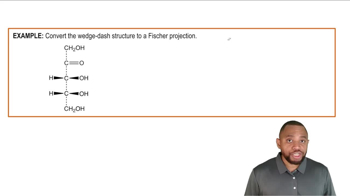Here are the essential concepts you must grasp in order to answer the question correctly.
Fischer Projection
A Fischer projection is a two-dimensional representation of a three-dimensional organic molecule, particularly useful for depicting stereochemistry. In this format, the vertical lines represent bonds that are oriented away from the viewer, while horizontal lines indicate bonds that are coming towards the viewer. This method is commonly used for carbohydrates and amino acids to illustrate their stereoisomers.
Recommended video:
Fischer Projections Example 1
Enantiomers
Enantiomers are a type of stereoisomer that are non-superimposable mirror images of each other. They typically arise in molecules that contain one or more chiral centers, where the arrangement of atoms around the chiral center leads to two distinct configurations. Understanding enantiomers is crucial in fields like pharmacology, as different enantiomers can have vastly different biological effects.
Recommended video:
Enantiomers vs Diastereomers Concept 1
Chirality
Chirality refers to the geometric property of a molecule that makes it non-superimposable on its mirror image, akin to how left and right hands are mirror images but cannot be perfectly aligned. Molecules that exhibit chirality often contain one or more chiral centers, typically carbon atoms bonded to four different substituents. Recognizing chirality is essential for understanding the behavior of molecules in biological systems and their interactions.
Recommended video:
 Verified step by step guidance
Verified step by step guidance Verified Solution
Verified Solution



 1:3m
1:3m